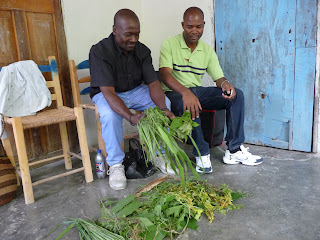 |
| Identifying forage for rabbits in Dourmond |
Partners of the Americas' small animal project in Haiti is growing rapidly, and many communities in Central and Southern Haiti now have the beginnings of a successful micro-enterprise. Below is the example of Dourmond, one of the most recent communities to receive rabbits. I expect that it won't be long before we begin hearing their stories as we do in other communities, where Haitians young and old are able to pay for their education through their profits from rabbit production. I hope to share some of those stories in later posts.
 |
| New rabbit cages arrive |
Even though rabbits may "breed like rabbits," a new project takes time and strategic thought. The project in Dourmond began in January 2009 with a feasibility study conducted by three individuals who are, collectively, leaders in Partners' Haiti
Farmer to Farmer Program, Makouti Agro Enterprise,
Devils Gulch Educational Services, and the
Patricia Sullivan Haitian Outreach Foundation. Dourmond turned out to have an appropriate supportive environment such as enough forage foods and motivation to raise rabbits, and the Foundation later supplied 30 cages to 30 women who make up the Association Femmes Chretiennes de Dourmond.
 |
| The rabbit training is well-attended |
|
Fast forward to April 2010, when Makouti and FTF staff built the cages in preparation for a training which took place in May. The training was conducted by FTF volunteer Myriam Kaplan-Pasternak, together with Makouti and "Racine," a successful rabbit raiser from another community where the project is active, Grand Boulage. As Myriam describes, "It was a real pleasure to watch Racine train the women. He has become very adept and confident at teaching rabbit production. We had only one rabbit to work with."

Once the new producers were trained, they received their first rabbits in July. A month later in August, I was able to visit Dourmond and witness first hand the excitement and progress in this community. The leader of the women's association (pictured below) confidently told us about the appropriate forages to feed the rabbits, surprising our local staff with her memory of each specific plant. The rabbits had offspring, and our staff explained that the relatively low mortality rates of the first baby rabbits indicate a beginning that is likely to be even more successful than that of the other more established and successful rabbit projects in other communities. With continued assistance, we hope that the families and children of this community will benefit long-term in the ways that others have.
 |
| Rabbit hutches are in place and full of rabbits, including offspring (August 2010) |
|
|
 |
| Young residents of Dourmond with Evaluation Specialist Volunteer Kerry Zaleski |









.png)

Comments
Post a Comment